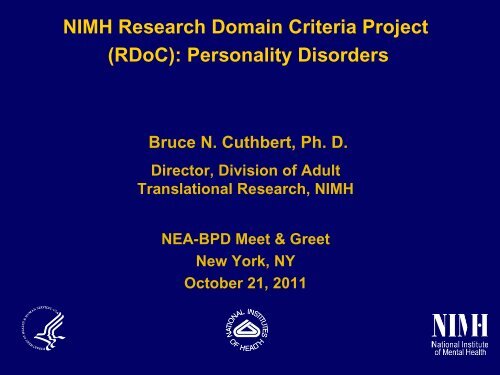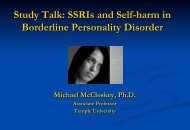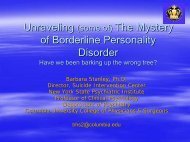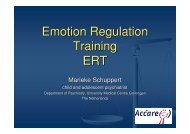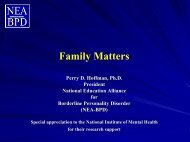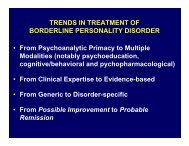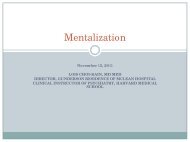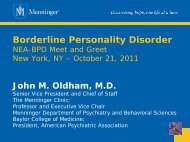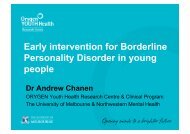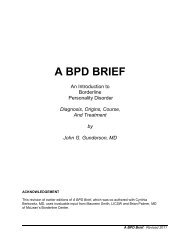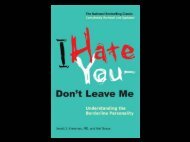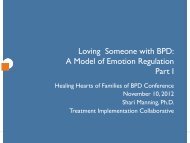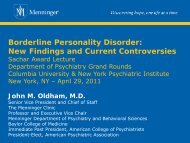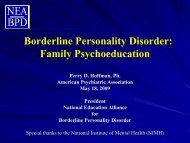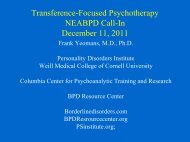RDoC - Borderline Personality Disorder
RDoC - Borderline Personality Disorder
RDoC - Borderline Personality Disorder
- No tags were found...
Create successful ePaper yourself
Turn your PDF publications into a flip-book with our unique Google optimized e-Paper software.
NIMH Research Domain Criteria Project(<strong>RDoC</strong>): <strong>Personality</strong> <strong>Disorder</strong>sBruce N. Cuthbert, Ph. D.Director, Division of AdultTranslational Research, NIMHNEA-BPD Meet & GreetNew York, NYOctober 21, 2011
NIMH Strategic Plan: Goal 1.4• “Develop, for research purposes, new ways ofclassifying mental disorders based on dimensions ofobservable behavior and neurobiological measures.”• Identify fundamental components that may span multipledisorders (e.g., executive function, affect regulation)• Develop reliable and valid measures of these fundamentalcomponents for use in basic and clinical studies• Determine the full range of variation, from normal to abnormal• Integrate genetic, neurobiological, behavioral, environmental,and experiential components10/24/2011 2
“If I only had a brain”:Toward new models of mental disorders• Shift from traditional clinicalphenomenological views(cognition/emotion, mind/brain) to aview of behavior grounded infundamental behavioraldimensions, as implemented bymajor brain circuits• I.e., treat our data as constructs• Measures in different responsesystems: behavior, self-reports(phenomenology), physiology10/24/20113
Continuity of motivational behaviorfrom animals to humans
The public intellectuals catch up…..
Dimensions of <strong>Borderline</strong> PDSkodol, Siever, et al.: Biol. Psychiatry, 51, 2002
<strong>Borderline</strong> as temperament variants, ca. 2003
Temperament and the Brain:Classic motivation centers
<strong>RDoC</strong>: MatrixConstruct: A concept summarizing data about a specified functionaldimension of behavior (and implementing genes and circuits).
<strong>RDoC</strong>: MatrixNegative Affectivity
<strong>RDoC</strong>: MatrixAntagonismNegative Affectivity
<strong>RDoC</strong>: MatrixAntagonismNegative AffectivityDisinhibition
<strong>RDoC</strong>: MatrixNegative AffectivityAntagonismDisinhibitionDetachment
Emotion regulation and the amygdala:Viewing threatening facesL/L 5-HTTLPRS carrier 5-HTTLPRPezawas, Meyer-Lindenberg, & …. Weinberger,Nature Rev. Neuros., 2005
Classic motivation centers
Emotion regulation in……• <strong>Borderline</strong> PD• Other PDs• Depression• Anxiety disorders• Bipolar disorder• ……….. Why not study the mechanism?10/24/2011 17
<strong>RDoC</strong> and Clinical Use• Not intended for clinical use at the current time• Clinical needs versus research needs• <strong>RDoC</strong>: To build up a literature that can lead to betterdiagnosis, and thus treatments• Agnostic to current disorders (Collins)• Is <strong>Borderline</strong> PD a cohesive syndrome, or a fuzzylocation in dimensional space? – to be determined10/24/2011 18
<strong>RDoC</strong>: Summary/Conclusions• Change in perspectives on psychopathology• Inform future versions of psychiatric diagnosis• Personalized medicine• New treatment development focused onbehavioral/brain mechanisms: Pharmacological,behavioral, devices, and combined10/24/2011 19


